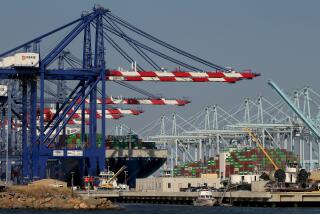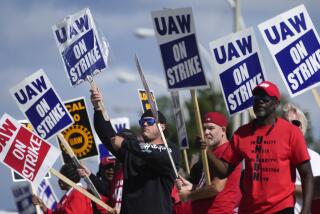Union Had Prepared Strategy to Counter Bankruptcy Filing
- Share via
When Frank Lorenzo took Continental Airlines into bankruptcy and abrogated his union contracts six years ago, he caught labor totally flat-footed.
Not Thursday.
As soon as Lorenzo, Texas Air Corp.’s chairman, announced that he was filing for Chapter 11 bankruptcy protection for Eastern Airlines, the striking International Assn. of Machinists countered swiftly. First, the union announced that it would extend its strike against Eastern to Continental, the other major subsidiary of Lorenzo’s Texas Air Corp., on the grounds that Continental workers are doing the “struck work” of Eastern employees.
Then, John Peterpaul, the machinists’ vice president, disclosed that the union already has prepared reorganization plans for Eastern that will be filed in federal bankruptcy court in New York early next week.
More Sophisticated Movement
The machinists’ rapid response Thursday is a strong sign of a changed, more sophisticated labor movement, said Harley Shaiken, professor of labor and technology at the University of California, San Diego.
“They’re widening the terrain of the conflict,” as they need to, Shaiken said. “If this were a normal collective bargaining situation, Lorenzo would be back at the table negotiating” because the strike has been so effective.
But that’s not happening. “What’s at stake for Lorenzo is more than a specific series of contract demands but rather a style of management that leaves little room for unions,” Shaiken said. “Simply to accept an economic settlement would fly in the face of what he’s done at Eastern,” said Shaiken, referring to Lorenzo’s sale of some of the company’s most valuable assets to Continental.
“The bankruptcy all along was seen as a possibility,” he added. “Now the question is to what extent can the unions grab on to additional leverage” beyond halting Eastern’s operations.
Indeed, the unions that have succeeded in the traditional strike goal of shutting down Eastern now will be tested on whether they can succeed in less familiar waters--bankruptcy court and wherever else they may choose to tangle.
Audrey Freedman, a labor economist with the Conference Board in New York, said the unions still face an uphill battle. “I guess they’re prepared, but I’m not sure it’s going to have any effect. They can’t preserve jobs this way or the wage structure or preserve the company,” she asserted.
“What they’ve done is speed up the dismantling of the company,” Freedman said. “Lorenzo seems determined to dismantle the airline. . . . There isn’t any way a union can prevent that.”
Union strategists are betting that she’s wrong and that they can play a key role in bringing Eastern back to life. “We meticulously prepared for this eventuality on this carrier,” said William Winpisinger, president of the machinists.
Washington-based lawyer and financial strategist Brian M. Freeman has prepared for the machinists a corporate reorganization plan for Eastern that will be unveiled next week. Freeman has been consulting with Ferrell Kupersmith, a Miami-based financial analyst who has been advising the Air Line Pilots Assn. at Eastern.
Machinists sources said it is likely that the union will press the bankruptcy judge to appoint a trustee who will tightly limit what Lorenzo can do while the bankruptcy process is moving forward.
Can Preserve His Cash
Nonetheless, one source close to the machinists acknowledged: “The real advantage of bankruptcy for Lorenzo is it allows him to preserve his cash. All his debt is frozen. This means he can devote all his cash to operations and fighting the strike, as opposed to paying creditors, of which he has many.”
But the unions do have a better hand in the bankruptcy court now than they did in 1983 with Continental, said Stephen P. Feldman, a Los Angeles attorney specializing in bankruptcy. As a result of changes in federal bankruptcy laws, in order to annul his union contracts, Lorenzo now has to pass a three-step test.
He must demonstrate that he has bargained in good faith, that the employees have refused to accept company proposals without good cause and that the balance of equities clearly favors eliminating existing collective bargaining agreements. “This is a very heavy burden,” Feldman said.
On the other hand, he said it would be much more difficult for the machinists to achieve their goal of having Continental and Texas Air brought into the bankruptcy. The machinists and the pilots assert that the companies are really a single entity and that is hard to prove legally, Feldman said.
In addition to the two tactics announced Thursday, the unions also will continue picketing Eastern, holding candlelight vigils at airports on the theme of “a thousand points of light,” will continue to press Congress to create a Presidential Emergency Board and attempt to get a “white knight,” such as financier Carl C. Icahn, chairman of Trans World Airlines, to purchase the company out of bankruptcy.
It is a multi-pronged strategy that is a result of considerable soul-searching that unions went through after many dismal defeats earlier in the decade. Lorenzo’s vanquishing of his unions through the preemptive use of bankruptcy in 1983 “taught the entire labor movement a lesson,” Winpisinger said.
“There’s been a heightened awareness ever since,” he said of the need to expand the weapons in labor’s arsenal. He said unions had begun utilizing the services of investment bankers and holding seminars for their members to explain the consequences of financial machinations.
Joe Uehlein, a strategist for the AFL-CIO’s industrial union department, said the unions would seek to wage a vigorous campaign against Continental by hitting it with a consumer boycott and other tactics.
On Thursday, Peterpaul, as well as officials of the Air Line Pilots Assn., said there was clear evidence that Continental employees were performing “struck work.” Seth D. Rosen, a pilots official, said that Continental supplied pilots and aircraft to haul Eastern passengers under the Continental logo. He cited examples of Eastern flights that were canceled from Philadelphia to Miami and Boston to Miami that then were flown by Continental planes and crews.
Additionally, Carla Winkler, president of the United Flight Attendants, the union that represents attendants at Continental, said that Continental had started to fly from New York’s La Guardia Airport to Miami and back, picking up an Eastern route. Normally, Continental flies from Newark.
“We have advised our members that this is struck work and they have a right not to cross a picket line” thrown up at such flights. She did not predict how many Continental attendants would honor lines. The company’s 7,500 attendants have been working without a contract for about five years.
Continental spokesman Ned Walker denied that Continental was performing “struck work” for Eastern. He said that Continental had merely moved in to fill a marketplace gap just as other carriers, such as Delta and TWA, had done. He predicted that pickets would have no impact on the company’s operations.
More to Read
Inside the business of entertainment
The Wide Shot brings you news, analysis and insights on everything from streaming wars to production — and what it all means for the future.
You may occasionally receive promotional content from the Los Angeles Times.










